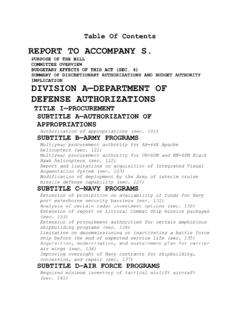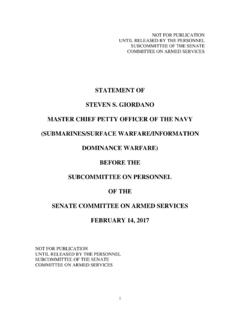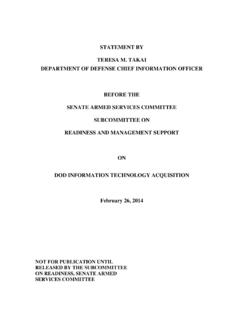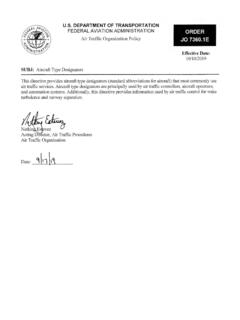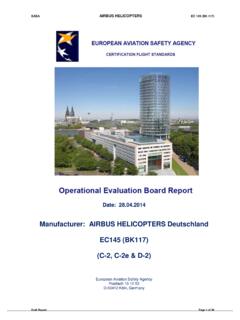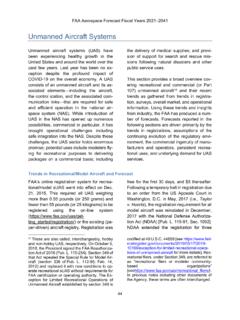Transcription of NATIONAL DEFENSE AUTHORIZATION ACT
1 NATIONAL DEFENSEAUTHORIZATION Senator Jack Reed, Chairman Senator Jim Inhofe, Ranking Member Senate Armed ServicesCommitteeFISCAL YEAR 20221 PREFACE Each year, the NATIONAL DEFENSE AUTHORIZATION Act (NDAA) authorizes funding levels and provides authorities for the military and other critical DEFENSE priorities, ensuring our troops have the training, equipment, and resources they need to carry out their missions. On July 21, 2021, the Senate Armed Services Committee voted in bipartisan fashion, 23-3, to advance the NATIONAL DEFENSE AUTHORIZATION Act (NDAA) for Fiscal Year (FY) 2022 to the Senate floor. The United States is engaged in a strategic competition with China and Russia, near-peer rivals that do not accept global leadership or the international norms that have helped keep the peace for the better part of a century. This strategic competition is likely to intensify due to shifts in the military balance of power and diverging visions of governance models between China and Russia and the West.
2 This competition is now unfolding amidst a global pandemic, natural disasters, and the introduction of disruptive technologies. The interconnected nature of these threats will drive how the United States resources and transforms its tools of NATIONAL power to respond to these complex security challenges. The passage of the NATIONAL DEFENSE AUTHORIZATION Act for Fiscal Year 2022 is an important step in achieving that objective. FY 2022 DEFENSE FUNDING LEVELS The 61st annual NDAA supports a total of $ billion in fiscal year 2022 funding for NATIONAL DEFENSE . Within this topline, the legislation authorizes $ billion for the Department of DEFENSE (DOD) and $ billion for NATIONAL security programs within the Department of Energy (DOE). This legislation, like the President s budget request, does not include a separate Overseas Contingency Operations (OCO) request any war-related costs are included in the base budget.
3 FY22 DEFENSE Funding Levels (in billions of dollars) Department of DEFENSE $ Department of Energy $ NDAA Topline $ DEFENSE -related Activities Outside NDAA Jurisdiction $ NATIONAL DEFENSE Topline $ The bill allows up to $6 billion in general transfer authority for unforeseen higher-priority needs in accordance with normal reprogramming procedures. 2 MAJOR HIGHLIGHTS 1. Strengthens the All-Volunteer Force and improves the quality of life of the men and women of the total force (Active Duty, NATIONAL Guard, and Reserves), their families, and Department of DEFENSE civilian personnel, while reinforcing the principles of a strong, diverse, inclusive force; that force cohesion requires a command climate that does not tolerate extremism, sexual misconduct or sexual harassment; and that quality health care is a fundamental necessity for servicemembers and their families.
4 Includes funding to support a percent pay raise for both military servicemembers and the DOD civilian workforce. Amends the Military Selective Service Act to require the registration of women for Selective Service. Creates a new category of bereavement leave for military personnel that would permit servicemembers to take up to two weeks of leave in connection with the death of a spouse or child. Increases parental leave to 12 weeks for all servicemembers for the birth, adoption, or foster care placement of a child. Establishes a Basic Needs Allowance to ensure that all servicemembers can meet the basic needs of their families. Requires parity in special and incentive pays for members of the reserve and active components. Authorizes an increase in funding of $70 million for DEFENSE -wide Operations & Maintenance, Department of DEFENSE Education Activity, for Impact Aid, including $20 million for military children with severe disabilities.
5 2. Supports the DOD and provides the resources needed by the combatant commands to carry out the NATIONAL DEFENSE Strategy (NDS) and ensure the United States can out-compete, deter, and prevail against near-peer rivals. Authorizes fiscal year 2022 active-duty end strengths for the Army of 485,000; the Navy, 346,200; the Marine Corps, 178,500; the Air Force, 329,220; and the Space Force, 8,400. Establishes a Commission on the NATIONAL DEFENSE Strategy to provide an independent review and assessment of the forthcoming NDS. Extends and modifies the Pacific Deterrence Initiative and reiterates the committee s intent to improve our force posture in the Indo-Pacific, increase readiness and presence, and build the capabilities of our partners and allies to counter the growing threat from and increasing aggression of China. Expresses the sense of the committee that future investments under the Pacific Deterrence Initiative should be focused on military and non-military 3 infrastructure in the Indo-Pacific region to assist in distributed military operations and counter predatory Chinese infrastructure development practices.
6 Establishes the Arctic Security Initiative to improve DOD coordination in achieving objectives in the Arctic. 3. Enhances deterrence by recapitalizing and modernizing the nuclear triad; ensuring the safety, security, and reliability of our nuclear stockpile, delivery systems, and infrastructure; increasing capacity in theater and homeland missile DEFENSE ; and strengthening nonproliferation programs. Authorizes the activities of the NATIONAL Nuclear Security Administration (NNSA) at $ billion; the Department of Energy's other DEFENSE activities at $920 million; and the Department of Energy's nuclear energy activities at $ million. Authorizes the procurement of the Iron Dome short-range rocket DEFENSE system, David s Sling Weapon System, and Arrow 3 Upper Tier Interceptor Program to support our closest ally in the Middle East, Israel. Authorizes the Missile DEFENSE Agency to develop a highly reliable missile DEFENSE interceptor for the Ground-Based Midcourse DEFENSE system.
7 Authorizes $ million for the Cooperative Threat Reduction (CTR) program to stem the proliferation of nuclear, chemical and biological threats around the world. 4. Accelerates the modernization of the Department across all domains and operational capabilities by investing in research and development of cutting-edge technologies and delivering them in a timely manner to the force. Authorizes an increase of more than $1 billion in funds available for science and technology programs that fund cutting-edge research and prototyping activities at universities, small businesses, DEFENSE labs, and industry, including in critical areas such as artificial intelligence, microelectronics, advanced materials, 5G, and biotechnology. Authorizes an increase of more than $500 million in funding for DEFENSE Advanced Research Projects Agency s (DARPA) high-risk, high-payoff research, including in areas such as quantum computing and university research.
8 Implements a number of recommendations from the NATIONAL Security Commission on Artificial Intelligence, which the committee established in a previous NATIONAL DEFENSE AUTHORIZATION Act. Strengthens the language of the CHIPS Act to establish the NATIONAL network for microelectronics research and development to support the development of world-leading domestic microelectronics manufacturing capability. 4 Requires the Under Secretary of DEFENSE for Research and Engineering to conduct an analysis comparing the research and development efforts of the United States and China on certain critical, militarily-relevant technologies. 5. Improves the ability of our Armed Forces to counter threats and promote freedom of action in the information environment including by countering information warfare, foreign malign influence, competition below the level of direct conflict, and hybrid warfare.
9 Requires the Secretary of DEFENSE to submit a report on the activities and programs of DOD to implement the irregular warfare strategy consistent with the 2019 Irregular Warfare Annex to the NATIONAL DEFENSE Strategy (NDS). Requires the Secretary of DEFENSE to develop and implement security cooperation strategies for each of the geographic combatant commands. 6. Improves efficiencies in resource allocation within the Department through transformations of the planning and budgeting process, acquisition process, and management structure and culture. Establishes a Commission on Planning, Programming, Budgeting, and Execution (PPBE) Reform to provide an independent review and assessment of the PPBE process of DOD. Requires DOD Comptroller, along with DOD's Chief Information Officer (CIO) and Chief Data Officer, to submit a plan to consolidate the IT systems used to manage data and support the PPBE process.
10 Requires the Secretary of DEFENSE to establish a set of management innovation activities to better leverage commercial management best practices and expertise from leading management, public administration, and business schools to support modernization of Pentagon management practices. 7. Protects and strengthens our NATIONAL security industrial base by prioritizing supply chain security; improving technology security; and investing in next-generation technologies that will ensure military competitiveness. Directs the Comptroller General to conduct a comprehensive assessment of Research, Development, Test and Evaluation (RDT&E) authorities and other similar authorities and brief Congress on its findings. Requires the development a joint zero trust strategy and a model architecture for the Department of DEFENSE Information Network and a data management strategy.
